| Author |
Message |
Sean Flynt

|
 Posted: Wed 02 Apr, 2008 7:00 am Post subject: Info On Painted Barbuta, Other Helmets Posted: Wed 02 Apr, 2008 7:00 am Post subject: Info On Painted Barbuta, Other Helmets |
 |
|
Arms and Armour of the Medieval Knight includes a photograph of a black-painted barbuta (ca. 1445) with painted white edging and rivets. The caption leaves the impression that the paint is from the working life of the helmet and I certainly trust the authors. I'm a bit confused, though, because the helmet is pierced for a rib (now missing) around the face opening--the white paint would have been underneath the rib. I wonder if the helmet was simply reused/repainted after the loss of the rib. While there are good reasons to remove a visor, I'm not sure why anyone would remove the rib.
Does anybody have photos or any details on this or any other painted helmet of the mid-15th c.? I'm considering this treatment for a sallet of the same period. Can anybody cite a modern or contemporary source for painted mottoes or slogans on helmets in that period?
Thanks!
 Attachment: 10.64 KB Attachment: 10.64 KB
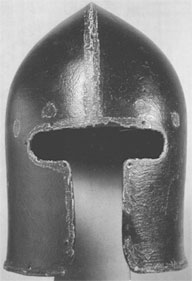
-Sean
Author of the Little Hammer novel
https://www.amazon.com/Little-Hammer-Sean-Flynt/dp/B08XN7HZ82/ref=sr_1_1?dchild=1&keywords=little+hammer+book&qid=1627482034&sr=8-1
|
|
   |
 |
Doug Strong

|
|
   |
 |
Corey D. Sullivan

|
 Posted: Thu 03 Apr, 2008 7:33 am Post subject: Posted: Thu 03 Apr, 2008 7:33 am Post subject: |
 |
|
Here are some more.
A few originals, as well as a pair of reproductions at a Company of St. George event in Germany.
 Attachment: 48.86 KB Attachment: 48.86 KB
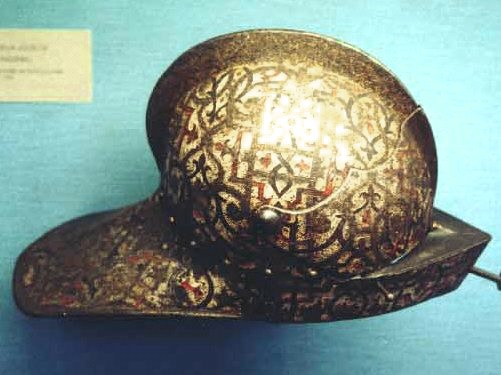
 Attachment: 96.73 KB Attachment: 96.73 KB
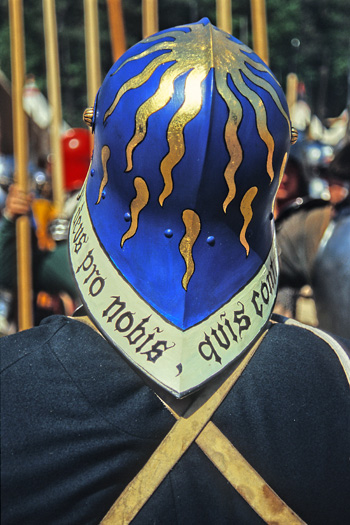
 Attachment: 80.25 KB Attachment: 80.25 KB
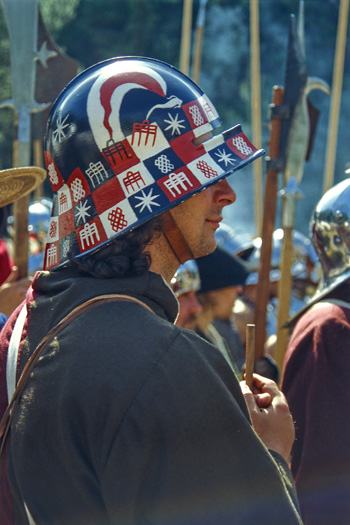
 Attachment: 97.44 KB Attachment: 97.44 KB
[ Download ]
"He had scantly finyshed his saienge but the one armye espyed the other lord how hastely the souldioures buckled their healmes how quikly the archers bent ther bowes and frushed their feathers how redely the byllmen shoke their bylles and proved their staves redy to appioche and loyne when the terrible trotnpet should sound the blast to victorie or deathe."
|
|
  |
 |
Sean Flynt

|
|
   |
 |
Chuck Russell

|
 Posted: Thu 03 Apr, 2008 5:14 pm Post subject: Posted: Thu 03 Apr, 2008 5:14 pm Post subject: |
 |
|
i used to have one almost like the third picture. it was blue with stars i think, its been a while so i can't remember fully. 
|
|
    |
 |
Doug Strong

|
 Posted: Sat 05 Apr, 2008 7:55 pm Post subject: Posted: Sat 05 Apr, 2008 7:55 pm Post subject: |
 |
|
There are surviging examples of painted armour from earlier. The bascinet (now in a private collection) formerly in the Heaver Castle collection was once painted. It woudl appear tit was painted with flames (like a hot rod!) There is a surviving painted great helm in the Germanishes National museum. That one is problematic. We kow it was painted ni 1626 but was it merely repainted or was it painted for the first time?
Dr. Douglas W. Strong
http://talbotsfineaccessories.com/
http://armourresearchsociety.org
|
|
   |
 |
Randall Moffett

|
 Posted: Sat 05 Apr, 2008 11:21 pm Post subject: Posted: Sat 05 Apr, 2008 11:21 pm Post subject: |
 |
|
DR. Strong,
I had never heard of a Bascinet painted. Yahoo!!!! I may paint some of the bascinets I am going to loan for the archers in the LH group with my arms then. Just because it will look cooler... and save time in perfect finishing.
RPM
|
|
  |
 |
Russ Thomas
Industry Professional

|
 Posted: Sun 06 Apr, 2008 3:55 am Post subject: Posted: Sun 06 Apr, 2008 3:55 am Post subject: |
 |
|
Corey,
The original sallet that you show, is in fact enamelled. The armourer Kunz Löchner of Nüremberg made a number of armours, for both man and horse, with this elaborate decorative treatment on. Great view of the helmet though ! 
Painted armour is something that we see all too seldom these days, and it is nice to see some people going to such great lengths to achieve the proper effect.
Regards,
Russ
Carpe diem, quam minimum credula postero !
http://www.living-history.no
|
|
   |
 |
|
Hendrik De Coster
|
 Posted: Thu 20 Nov, 2008 3:31 pm Post subject: Posted: Thu 20 Nov, 2008 3:31 pm Post subject: |
 |
|
what paint do you actually use to paint a helmet?
ordinary metal paint from the hardware store?sinc ei might be interested in painting my sallet
|
|
    |
 |
Olov Tidemalm

|
 Posted: Fri 21 Nov, 2008 7:52 am Post subject: Posted: Fri 21 Nov, 2008 7:52 am Post subject: |
 |
|
Here is another one:
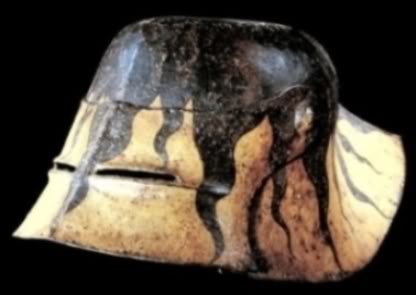
|
|
  |
 |
|
Hendrik De Coster
|
 Posted: Fri 21 Nov, 2008 8:52 am Post subject: Posted: Fri 21 Nov, 2008 8:52 am Post subject: |
 |
|
corey
do you have any better pictures of that blue helmet of the company of saint george?loke it's front and side view?
i'm relly interested in that one
|
|
    |
 |
Sean Flynt

|
|
   |
 |
Sean Flynt

|
 Posted: Fri 21 Nov, 2008 10:53 am Post subject: Posted: Fri 21 Nov, 2008 10:53 am Post subject: |
 |
|
By the way, when I was thinking about doing something like this I Googled "free medieval fonts" and came up with some nice gothic German fonts. You just download, key-in your text, change the font, adjust the size to suit your border and print. You can either just copy by eye or outline the letters with pinpricks, tape the page to helmet and spraypaint in a color slightly lighter than the background. When dry, you can remove the paper and play connect-the-dots to finish the border, covering the guide dots.
-Sean
Author of the Little Hammer novel
https://www.amazon.com/Little-Hammer-Sean-Flynt/dp/B08XN7HZ82/ref=sr_1_1?dchild=1&keywords=little+hammer+book&qid=1627482034&sr=8-1
|
|
   |
 |
|
Sylvain Boissel
Location: France Joined: 15 Nov 2008
Posts: 1
|
 Posted: Tue 09 Dec, 2008 11:36 pm Post subject: Posted: Tue 09 Dec, 2008 11:36 pm Post subject: |
 |
|
| Olov Tidemalm wrote: | Here is another one:
 |
Do you have some info of this sallet (date, origin, where it is now...), please ?
|
|
  |
 |
Olov Tidemalm

|
 Posted: Wed 10 Dec, 2008 1:05 pm Post subject: Posted: Wed 10 Dec, 2008 1:05 pm Post subject: |
 |
|
|
The only thing I know about is that it's from southern germany and pre 1600. But by the looks of it I'd say 1490-1500. (: I'm gonna paint my kettelhat in the same way. I'll post pics of it when I'm done.
|
|
  |
 |
|
Ivo Malz
Location: Hanau, Germany Joined: 08 Jan 2005
Posts: 30
|
 Posted: Sun 14 Dec, 2008 8:42 am Post subject: Posted: Sun 14 Dec, 2008 8:42 am Post subject: |
 |
|
Hello.
As to the "enamelled" armour, the material we are talking about is "cold enamel" or in other words, lacquer.
As to the painted "Black Sallets", most of the painted surfaces on these have been applied later than the helmets' working life. The many pairs of small holes in the majority of them are a relatively sure giveaway for their originally being covered, most likely in some fashion of tooled leather, going by the famous Dürer ( an contemporaries') sketches.
Regards
Ivo
|
|
  |
 |
Steven H

|
 Posted: Sun 14 Dec, 2008 11:36 am Post subject: Posted: Sun 14 Dec, 2008 11:36 am Post subject: |
 |
|
| Ivo Malz wrote: | The many pairs of small holes in the majority of them are a relatively sure giveaway for their originally being covered, most likely in some fashion of tooled leather, going by the famous Dürer ( an contemporaries') sketches.
|
I'm not familiar with these pictures (or most Durer's work unfortunately). Could you provide some examples?
I always like examples of ways to cover helmets and armour. So much niftier than more polished metal.
Thanks,
Steven
Kunstbruder - Boston area Historical Combat Study
|
|
   |
 |
|
Lafayette C Curtis
|
 Posted: Sun 14 Dec, 2008 11:21 pm Post subject: Posted: Sun 14 Dec, 2008 11:21 pm Post subject: |
 |
|
| Steven H wrote: | | I'm not familiar with these pictures (or most Durer's work unfortunately). Could you provide some examples? |
Like this?
http://commons.wikimedia.org/wiki/File:Duerer...r_1495.jpg
(I'm not sure if the helmet shown there is leather-covered; it could just as well be painted and I wouldn't know enough to tell the difference!)
|
|
  |
 |
|
Ivo Malz
Location: Hanau, Germany Joined: 08 Jan 2005
Posts: 30
|
 Posted: Tue 16 Dec, 2008 4:02 am Post subject: Posted: Tue 16 Dec, 2008 4:02 am Post subject: |
 |
|
That exactly is the study I was referring to, thank you so much. The little text above the rider roughly translates with "This was the armour worn around that time (i.e. late 1490s), a rare snapshot from history, so to speak.
The sketch to my eye quite clearly shows a helmet cover of some sort, just compare the rounded edges of the helmet bowl to the way crisper lines of the visor and the rest of the riders' armour.
Surviving pieces usually are rough from the hammer and made from fairly thin metal, plus they have pairs of holes all over the helmet bowl, sometimes even the visor. Quite a dead giveaway for a cover of some sort.
Black sallets, by the way, were not knightly helmets for the upper crust, they rather were a rough affair for light cavalry. Some even had a moving visor the visions of which couldn't be seen through properly unless you tilted the helmet all the way over your eyes making the rear stand up like a duck tail at roughly 45° offering no neck protection whatsoever.
This effect can be seen in at least one movie, good reproductions worn bad, so to speak.
Black sallets technically were kettle hats with a rudimentary visor and visions at a completely useless position, just like the early Roman pseudo- Corinthian helmets, that rudimentary had all features, the nasal and y- face and cheekpiece shape and all, but on a helmet that was worn on top of the head like a fez.
|
|
  |
 |
Sean Flynt

|
 Posted: Tue 16 Dec, 2008 7:09 am Post subject: Posted: Tue 16 Dec, 2008 7:09 am Post subject: |
 |
|
It seems pretty reasonable for light cavalry to have a helmet that could be pulled down over the eyes for a lance charge--not much threat from the rear, so no need for the extra weight required to cover both the upper face and back of neck. If the wearer pulls the visor/helmet down so the sights function and leans forward to brace the lance and present a smaller target, even that shallow visor should provide a decent deflecting surface over most of the face. Short of trying on an original or good reproduction, it's impossible to say how the design worked.
-Sean
Author of the Little Hammer novel
https://www.amazon.com/Little-Hammer-Sean-Flynt/dp/B08XN7HZ82/ref=sr_1_1?dchild=1&keywords=little+hammer+book&qid=1627482034&sr=8-1
|
|
   |
 |
|
|

